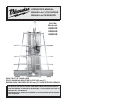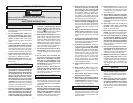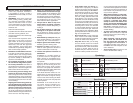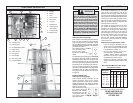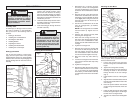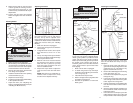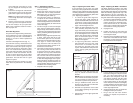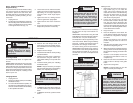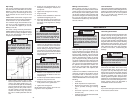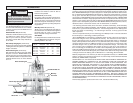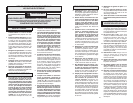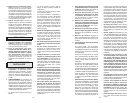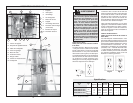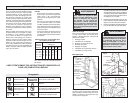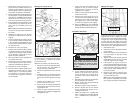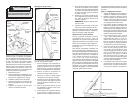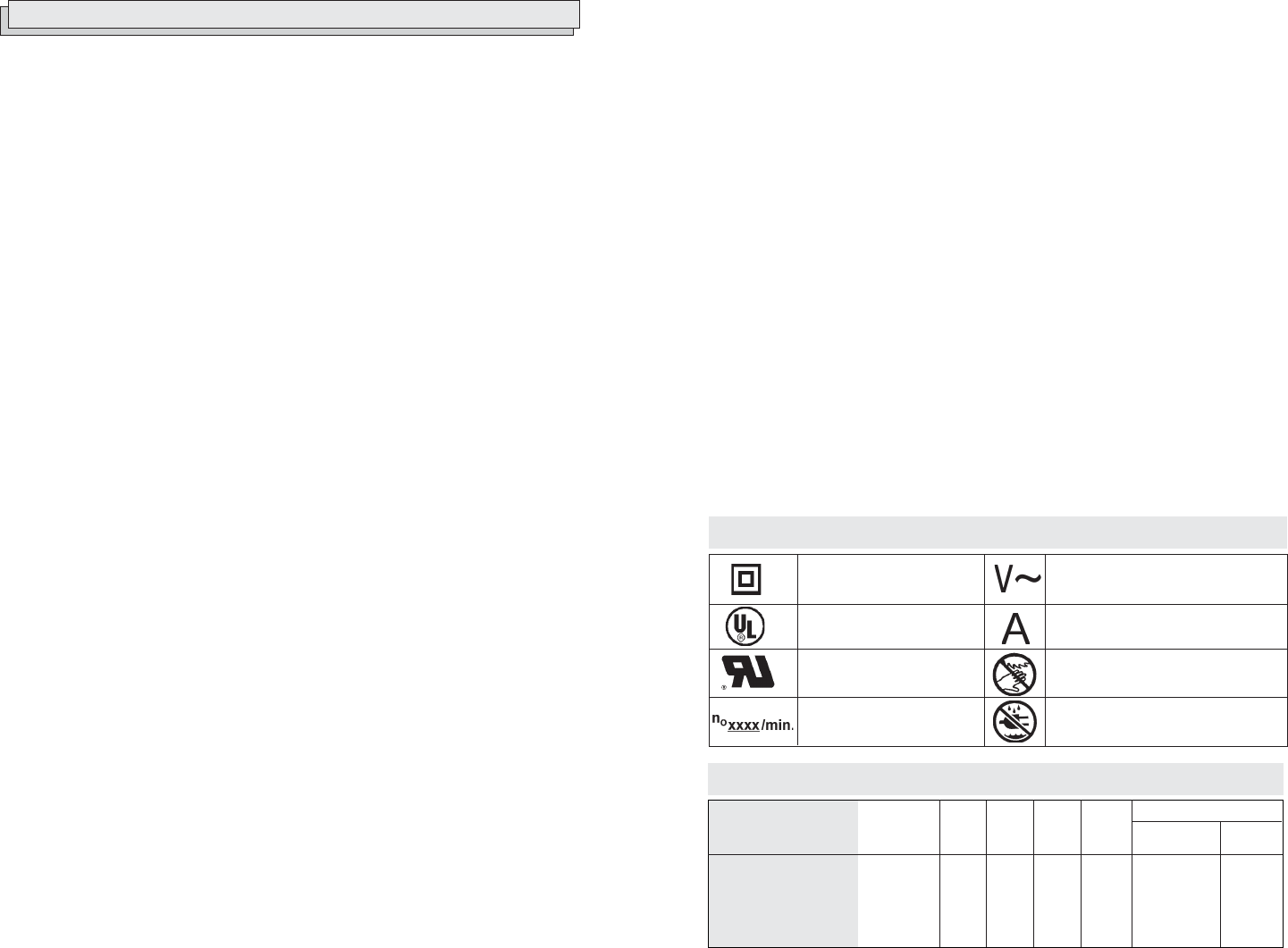
4 5
8. Never cut a workpieces with a width
smaller than that of the saw carriage.
Proper support for the workpiece must
be maintained to insure safety. When
the carriage moves over the workpiece,
it would be impossible to safely support
the workpiece for the cut. Use a tool
better suited for these applications.
9. Always wait for blade to stop com-
pletely before changing positions.
Unplug the tool before transporting or
moving it.
10. Do not place hands on or under saw
carriage or in the path of the blade.
Do not attempt to retrieve a piece of
material that is cut off while the blade is
rotating.
11. Make workshop child proof with pad-
locks, master switches, or by removing
starter keys. See "Lock-Off Feature".
12. Replace guards after blade change.
Maintain guards in working order.
13. Direction of feed. Feed work into a
blade or cutter against the direction of
rotation of the blade or cutter only.
14. Causes and Operator Prevention of
KICKBACK:
KICKBACK is a sudden reaction to
a pinched, bound or misaligned saw
blade, causing an uncontrolled saw to
lift up and out of the workpiece toward
the operator.
When the blade is pinched or bound
tightly by the kerf closing down, the
blade stalls and the motor reaction
drives the unit rapidly back toward the
operator when cross-cutting and throws
out the workpiece if ripping.
If the blade becomes twisted or mis-
aligned in the cut, the teeth at the back
edge of the blade can dig into the top
surface of the wood causing the blade
to climb out of the kerf and jump back
toward operator.
KICKBACK is the result of tool mis-
use and/or incorrect operating pro-
cedures or conditions and can be
avoided by taking proper precautions as
given below:
• Keep blade clean and sharp. Un-
sharpened or improperly set blades
produce narrow kerf causing excessive
friction, blade binding and KICKBACK.
Any blade with a small set, even though
sharp, may be likely to kick back. A dull
blade encourages the operator to force
the saw, causing reduced control and
blade binding. The excessive friction
generated can cause the blade to warp
or bind. Use only blades which are rec-
ommended for use with your tool. Do not
use blades with incorrect size or shaped
mounting holes. Never use defective
or incorrect blade washers or bolts. Be
sure the blade bolt is tight. Select the
proper blade for the application. Blade
speed specifi cations must be at least as
high as nameplate RPM.
• Do not force tool. Let the saw do the
work. A saw is more readily controlled
and will do a better job when used in the
manner for which it was designed.
• Stay alert. Watch what you are doing
and use common sense. Do not allow
yourself to be distracted. Do not oper-
ate tool when tired, under the infl uence
of drugs or alcohol. Hold the tool or
material fi rmly and exercise control at
all times. Position yourself and co-work-
SPECIFIC SAFETY RULES
1. Maintain labels and nameplates.
These carry important information.
If unreadable or missing, contact a
MILWAUKEE service facility for a free
replacement.
2. WARNING! Some dust created by
power sanding, sawing, grinding, drill-
ing, and other construction activities
contains chemicals known to cause
cancer, birth defects or other reproduc-
tive harm. Some examples of these
chemicals are:
• lead from lead-based paint
• crystalline silica from bricks and cement
and other masonry products, and
• arsenic and chromium from chemically-
treated lumber.
Your risk from these exposures varies,
depending on how often you do this
type of work. To reduce your exposure
to these chemicals: work in a well ven-
tilated area, and work with approved
safety equipment, such as those dust
masks that are specifi cally designed to
fi lter out microscopic particles.
3. Handle the counterbalance with care.
The cable is under tension. Always as-
semble cable to saw carriage before
removing cable clip. Do not pull on cable
by hand or attempt to disassemble or
repair the counterbalance.
4. Do not defeat the guards or operate
the tool without the guards in place.
5. Do not use push sticks. Push sticks or
the workpiece can kick back, cause the
blade to pinch, or become caught in the
blade and be thrown from the tool.
6. Cross-cutting (vertical cutting) must
always be done from the top down.
Saw carriage should be raised to the
uppermost position on the guide tubes
and locked into position with the carriage
lock whenever the tool is not in use. See
"Cross-Cutting".
7. Ripping (horizontal cutting) must rip-
ping must always be done by moving
the workpiece through the saw in the
direction of the arrow on the saw mo-
tor. Saw carriage should be raised to the
top of the guide tubes and locked into
position with the carriage lock whenever
tool is not in use. See "Rip Cutting".
ers out of the kick back path. Repetitive
cuts which lull the operator into careless
movements can also cause kick back. A
brief "stretch" may be all that is neces-
sary to avoid a problem.
• When blade is binding, or when inter-
rupting a cut for any reason, turn the
switch off and hold the saw motion-
less in the material until the blade
comes to a complete stop. Never
attempt to remove the saw from the
work or pull the saw backward while
the blade is in motion or KICKBACK
may occur. Investigate and take cor-
rective actions to eliminate the cause
of blade binding.
• To remove the blade after stopping
mid-cut, allow the blade to stop and
then back up the saw (cross-cutting) or
board (rip-cutting).
• When restarting a saw in the work-
piece, center the saw blade in the
kerf and check that saw teeth are
not engaged into the material. If
saw blade is binding, it may walk up or
KICKBACK from the workpiece as the
saw is restarted.
• Avoid cutting nails. Inspect for and
remove all nails before cutting.
Amperes
Double Insulated
Symbology
Underwriters Laboratories, Inc.
Volts Alternating Current
No Load Revolutions
per Minute (RPM)
Speed
5800
5800
5800
5800
Volts
AC
120
120
220-240
220-240
Cat.
No.
6480-20
6486-20 (motor only)
6485-68 (motor only)
6486-68 (motor only)
Specifi cations
Amps
15
15
7.5
7.5
Do not place hands on or under saw
carriage or in the path of the blade.
Do not expose to rain or use in damp
locations.
Blade
Size
8-1/4"
8-1/4"
8-1/4"
8-1/4"
Arbor
5/8"
5/8"
5/8"
5/8"
Thickness
1-3/4"
- -
- -
- -
Height
50"
- -
- -
- -
Capacity *
* For additional limitations, see the "Rip Cutting" and "Cross-cutting" sections.
Underwriters Laboratories, Inc.,
Recognized Component



